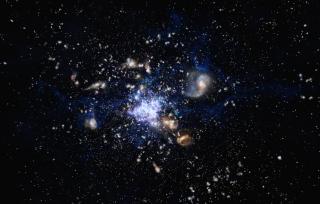Bibcode
Shimakawa, Rhythm; Pérez-Martínez, Jose Manuel; Koyama, Yusei; Tanaka, Masayuki; Tanaka, Ichi; Kodama, Tadayuki; Hatch, Nina A.; Röttgering, Huub J. A.; Dannerbauer, Helmut; Kurk, Jaron D.
Bibliographical reference
Monthly Notices of the Royal Astronomical Society
Advertised on:
2
2024
Citations
14
Refereed citations
14
Description
As a considerable investment of time from various telescope facilities was dedicated toward studying the Spiderweb protocluster at z = 2.2, it so far remains one of the most extensively studied protocluster. We report here the latest results in this field, adding a new dimension to previous research on cluster formation at high redshift. Previous studies have reported a significant overdensity (δ ~ 10) of massive Hα (+ [N II])-emitting galaxies in 3700 comoving Mpc3. Many of these were previously considered to be dusty, actively star-forming galaxies, given their rest-frame optical and infrared features. However, this study argues that a third of them are more likely to be 'passively evolving' galaxies with low-luminosity active galactic nuclei (AGNs) rather than star-forming galaxies, given the multiwavelength spectral energy distribution (SED) fitting including an AGN component. For their SED-based star formation rates to be valid, bulk of their Hα + [N II] emission should come from the central AGNs. This difference in interpretation between this work and past studies, including ours, is particularly supported by the recent deep Chandra/X-ray observation. Furthermore, we have spectroscopically confirmed a quiescent nature for one of these AGNs, with its multiple stellar absorption lines but also low-ionization emission lines. This important update provides new insights into the role of AGNs in forming the cluster red sequence observed in the present-day universe.
Related projects

Molecular Gas and Dust in Galaxies Across Cosmic Time
Two of the most fundamental questions in astrophysics are the conversion of molecular gas into stars and how this physical process is a function of environments on all scales, ranging from planetary systems, stellar clusters, galaxies to galaxy clusters. The main goal of this internal project is to get insight into the formation and evolution of
Helmut
Dannerbauer